Immune Responses Against Autointracellular Pathogenic Genomes or Cancered Cells
Article Information
Feleke Eriso*
Biomedical Stream, Department of Biology, College of Natural and Computational Science, Dilla University, Dilla, Ethiopia
*Corresponding Author: Dr. Feleke Eriso, Biomedical Stream, Department of Biology, College of Natural and
Computational Science, Dilla University, Dilla, Ethiopia
Received: 13 April 2018; Accepted: 27 April 2018; Published: 30 April 2018
Citation: Feleke Eriso. Immune Responses Against Autointracellular Pathogenic Genomes or Cancered Cells. Journal of Cancer Science and Clinical Therapeutics 2 (2018): 73-83.
View / Download Pdf Share at FacebookAbstract
Cancer, also termed malignancy is a disease characterized by an uncontrolled growth of cells, i.e., an abnormal growth of immortal cells with no apoptosis. More than 100 types of cancer are known, including breast cancer, skin cancer, colon cancer, prostate cancer, and lymphoma. What makes a cell a cancered one is the autointracellular pathogenic genome, or “cancerous genome” located inside that cancered cell. The code of design of constructing or building the body of every species of all living-things is found in its genome; the same is true with the pathogenic genome in building the body of cancered cells (host cells). Three major types of tumor suppressor genes are known to code for proteins that suppress growth of cells: (i) one type tells cells to slow down and stop dividing, (ii) the second type is responsible for fixing changes (repairing) in damaged cells, and (iii) the third type is in charge of apoptosis (the programmed death of cell). If mutations that can inactivate any of these tumor suppressor genes occur, cancer will be onset and allow cancered cells to grow unchecked. The cytotoxic T cells and NK cells are 100% correct in identifying the cancered cell foreign to the body of the patient just as they identify virus-infected cells, because the genome inside the cancered cell is foreign to the body of the patient as it is transformed into a completely different genome from those found in the body of patient. The genome is transformed by a multitude of mutations referred to as driver mutations. The transformed genome is said pathogenic because it causes the dangerous disease called cancer. As the genome is changed or transformed all biological molecules/biomass of its cells produced by the coded information or directives of this changed genome are foreign (nonself) to the body of the patient and that is why the killer immune cells recognize the cancered cell as foreign to the body of the patient and kill it. Unl
Keywords
Apoptosis, Autointracellular pathogenic genome, Cancer, Cancered cell, Driver mutations, Foreign antigens, Immortal cells, Immune responses, Metastatic growth
Apoptosis articles Apoptosis Research articles Apoptosis review articles Apoptosis PubMed articles Apoptosis PubMed Central articles Apoptosis 2023 articles Apoptosis 2024 articles Apoptosis Scopus articles Apoptosis impact factor journals Apoptosis Scopus journals Apoptosis PubMed journals Apoptosis medical journals Apoptosis free journals Apoptosis best journals Apoptosis top journals Apoptosis free medical journals Apoptosis famous journals Apoptosis Google Scholar indexed journals Autointracellular pathogenic genome articles Autointracellular pathogenic genome Research articles Autointracellular pathogenic genome review articles Autointracellular pathogenic genome PubMed articles Autointracellular pathogenic genome PubMed Central articles Autointracellular pathogenic genome 2023 articles Autointracellular pathogenic genome 2024 articles Autointracellular pathogenic genome Scopus articles Autointracellular pathogenic genome impact factor journals Autointracellular pathogenic genome Scopus journals Autointracellular pathogenic genome PubMed journals Autointracellular pathogenic genome medical journals Autointracellular pathogenic genome free journals Autointracellular pathogenic genome best journals Autointracellular pathogenic genome top journals Autointracellular pathogenic genome free medical journals Autointracellular pathogenic genome famous journals Autointracellular pathogenic genome Google Scholar indexed journals Cancer articles Cancer Research articles Cancer review articles Cancer PubMed articles Cancer PubMed Central articles Cancer 2023 articles Cancer 2024 articles Cancer Scopus articles Cancer impact factor journals Cancer Scopus journals Cancer PubMed journals Cancer medical journals Cancer free journals Cancer best journals Cancer top journals Cancer free medical journals Cancer famous journals Cancer Google Scholar indexed journals Cancered cell articles Cancered cell Research articles Cancered cell review articles Cancered cell PubMed articles Cancered cell PubMed Central articles Cancered cell 2023 articles Cancered cell 2024 articles Cancered cell Scopus articles Cancered cell impact factor journals Cancered cell Scopus journals Cancered cell PubMed journals Cancered cell medical journals Cancered cell free journals Cancered cell best journals Cancered cell top journals Cancered cell free medical journals Cancered cell famous journals Cancered cell Google Scholar indexed journals Driver mutations articles Driver mutations Research articles Driver mutations review articles Driver mutations PubMed articles Driver mutations PubMed Central articles Driver mutations 2023 articles Driver mutations 2024 articles Driver mutations Scopus articles Driver mutations impact factor journals Driver mutations Scopus journals Driver mutations PubMed journals Driver mutations medical journals Driver mutations free journals Driver mutations best journals Driver mutations top journals Driver mutations free medical journals Driver mutations famous journals Driver mutations Google Scholar indexed journals Foreign antigens articles Foreign antigens Research articles Foreign antigens review articles Foreign antigens PubMed articles Foreign antigens PubMed Central articles Foreign antigens 2023 articles Foreign antigens 2024 articles Foreign antigens Scopus articles Foreign antigens impact factor journals Foreign antigens Scopus journals Foreign antigens PubMed journals Foreign antigens medical journals Foreign antigens free journals Foreign antigens best journals Foreign antigens top journals Foreign antigens free medical journals Foreign antigens famous journals Foreign antigens Google Scholar indexed journals Immortal cells articles Immortal cells Research articles Immortal cells review articles Immortal cells PubMed articles Immortal cells PubMed Central articles Immortal cells 2023 articles Immortal cells 2024 articles Immortal cells Scopus articles Immortal cells impact factor journals Immortal cells Scopus journals Immortal cells PubMed journals Immortal cells medical journals Immortal cells free journals Immortal cells best journals Immortal cells top journals Immortal cells free medical journals Immortal cells famous journals Immortal cells Google Scholar indexed journals Immune responses articles Immune responses Research articles Immune responses review articles Immune responses PubMed articles Immune responses PubMed Central articles Immune responses 2023 articles Immune responses 2024 articles Immune responses Scopus articles Immune responses impact factor journals Immune responses Scopus journals Immune responses PubMed journals Immune responses medical journals Immune responses free journals Immune responses best journals Immune responses top journals Immune responses free medical journals Immune responses famous journals Immune responses Google Scholar indexed journals Metastatic growth articles Metastatic growth Research articles Metastatic growth review articles Metastatic growth PubMed articles Metastatic growth PubMed Central articles Metastatic growth 2023 articles Metastatic growth 2024 articles Metastatic growth Scopus articles Metastatic growth impact factor journals Metastatic growth Scopus journals Metastatic growth PubMed journals Metastatic growth medical journals Metastatic growth free journals Metastatic growth best journals Metastatic growth top journals Metastatic growth free medical journals Metastatic growth famous journals Metastatic growth Google Scholar indexed journals cytotoxic articles cytotoxic Research articles cytotoxic review articles cytotoxic PubMed articles cytotoxic PubMed Central articles cytotoxic 2023 articles cytotoxic 2024 articles cytotoxic Scopus articles cytotoxic impact factor journals cytotoxic Scopus journals cytotoxic PubMed journals cytotoxic medical journals cytotoxic free journals cytotoxic best journals cytotoxic top journals cytotoxic free medical journals cytotoxic famous journals cytotoxic Google Scholar indexed journals
Article Details
1. Introduction
Immune system can recognize the cancered cells as well as tumor specific antigens (TSA) and can mount an immune response using different types of cells such as CD4+ TH cells which secrete several cytokines like IL-2, and IFN-? which lead to activation of cytotoxic Tc cells. CD8+ Tc cells are the actual mercenaries of the cancered cells that initiate lysis/destruction of cancered cells through perforin activation. NK cells kill those cells with pathogenic genome inside them through ADCC and lyse them post contact. Since NK cells are not MHC restricted and their destructive activity is increased by IFN-?, IL-2, and IL-12. NK cells are the most potent weapons against the cancered cells [1, 2].
The central role of macrophages to almost all immune processes is strongly visible here. Macrophages help in eradication of tumors through their multifaceted armory which includes respiratory burst, N release, proteinases, TNF-?, and ADCC amongst others. Cancer does occur in plants, but they are less vulnerable to its effects because vegetable tumor does not metastasize as plant cellsare typically locked in place by a matrix of rigid cell walls, so they cannot migrate [3, 4].
1.1 Natural Killer Cells or NK Cells
- are a type of cytotoxic lymphocyte critical to the immune system.
- The role of NK cells played is analogous to that of cytotoxic T cells in the vertebrate adaptive immune response.
- NK cells provide rapid responses viral-infected cells, acting at around 3 days after infection, and respond to tumor formation.
- Typically, immune cells detect major histocompatibility complex (MHC) presented on infected cell surfaces, triggering cytokine release so as to cause lysis or apoptosis.
- NK cells are unique, as they have the ability to recognize stressed cells in the absence of antibodies and MHC, allowing for a much faster immune reaction.
- They were named “natural killers” because of the initial notion that they do not require activation to kill cells that are missing “self” markers of MHC class I. This role is especially important because harmful cells that are missing MHC I markers cannot be detected and destroyed by other immune cells, such as T lymphocyte cells.
- NK cells (belonging to the group of innate lymphoid cells) are defined as large granular lymphocytes and constitute the third kind of cells differentiated from the common lymphoid progenitor-generating B and T lymphocytes.
- NK cells are known to differentiate and mature in the bone-marrow, lymph nodes, spleen, tonsils, and thymus, where they then enter into the circulation.
- NK cells differ from natural killer T cells NKTs) phenotypically, by origin and by respective effector functions; often, NKT cell activity promotes NK cell activity by secreting interferon gamma. In contrast to NKT cells, NK cells do not express T-cell receptors (TCR) or pan T marker CD3 or surface Immunoglobulins (Ig) B cells receptors, but they usually express the surface markers CD16 (FcyRIII) and CD56 in humans, NK1.1 or NK1.2 in C57BL/6 mice. The NKp46 cell surface marker constitutes, at the moment, another NK cell marker of preference being expressed in both humans, several strains of mice including BALB/c mice) and three monkey species [5-9].
In addition to the knowledge that natural killer cells are effectors of innate immunity, recent research has uncovered information on both activating and inhibitory NK cell receptors which play important functional roles, including self tolerance and the sustaining of NK cell activity. NK cells also play a role in the adaptive immune response: numerous experiments have demonstrated their ability to readily adjust to the immediate environment and formulate antigen-specific immunological memory, fundamental for responding to secondary infections with the antigen. The role of NK cells in both the innate and adaptive immune responses is becoming increasingly important in research using NK cell activity as a potential cancer therapy [10-14].
1.2 Key objectives
- To substanciate/verify that the genome of a cancered cell is a pathogenic genome.
- To display that the actual & spectacular types/mechanisms of horrible pathogenesis/cancer is caused by the pathogenic genome that is found inside the cancered cell. Transformation of a normal genome (inside a normal cell) into a pathogenic or cancerous genome is caused by a multitude of mutations that are referred to as driver mutations.
2. Review
What makes a cell a cancered one is the autointracellular pathogenic genome, or “cancerous genome” located inside that cancered cell. A cell is a living-thing and a living-thing is the product of reaction of its genome and its nutritive substances in its compatible environment. The pathogenic genome is the transformer of nutritive substances of a cancered cell into countably infinite number of canered cells of its kind just like any other normal genome of all living-things. It is a normal genome that is transformed into a pathogenic genome by a multitude of mutations
known as driver mutations which form the driving force of the metastatic growth of cancered cells. The genome is a self-replicating, i.e., a self-producing structure and it is the only structure that produces/constructs all other structural molecules or “biomass” in all species of living-things [15, 16]. The code of design of constructing or building the body of a living-thing of every species of all living-things is found in its genome. The same is true with the pathogenic genome in cancered cells [17].
The term cancer cell is a confusing or a misleading term in which a host cell & the pathogen are undistinguished for student children of both pure and applied biological sciences. It is also full of ambiguity to scientists of biological sciences by the fact that its scientific truth is incompatible with the language it has to be imparted through. In short, the term cancer cell is an erroneous, inappropriate, and turbid term that cannot be presented to learner kids who are the seedlings to be better scientists of tomorrow. The reason for why the term cancer cell came into being or existed in the system of living-things is due to the lack of deep understanding about the role of genome in all living-things. The term cancer cell or cancerous cell dares to mean that the host cell (i.e., cancer cell or cancerous cell) is the pathogenic cell that causes cancer. This concept of terminology is wrong and we must get it removed from courses of learner kids of the world. In fact, the cancer cell is the host cell which is infected (cancered) by autointracellular pathogenic genome or cancerous genome found inside the host cell itself.
2.1 Growth regulation in normal cells
The growth of normal cells is controlled by growth or tumor suppressors. Three major types of tumor suppressor genes are known to code for proteins that suppress growth of cells.
- one type tells cells to slow down and stop dividing,
- the second type is responsible for fixing changes (repairing) in damaged cells, and
- the third type is in charge of apoptosis (the programmed death of cell).
If mutations that can inactivate any of these tumor suppressor genes occur, cancer will be onset and allow cancered cells to grow unchecked.
2.2 Concrete evidence for the presence of an “autointracellular pathogenic genome” in a cell
In cell-mediated immunity cells like cytotoxic T cells and Natural Killer cells recognize host cells infected with intracellular pathogens such as viruses and kill them. The same killer cells of the cell-mediated immunity do recognize a cancered cell as a cell infected with a foreign intracellular pathogen and kill it exactly as they kill the virus-infected host cells. The cytotoxic T cells and NK cells are 100% correct in identifying the cancered cell as an infected cell with intracellular pathogen, because the genome inside the cancered cell is foregn to the body of the patient as it is transformed into a completely different genome by a multitude of mutations referred to as driver mutations. As the genome is changed or transformed all the biological molecules/biomass of its cells produced by the coded information or directives of this changed genome are foreign (nonself) to the body of the patient and that is why the killer immune cells recognize the cancered cell as foreign to the body of the patient and kill it. Unlike the genomes of the normal cells in the body of the patient, the changed genome makes the cancered cells (host cells)
immortal, promotes uncontrolled rapid cell divisions, metastatic growth of cancered cells and bans apoptosis. Thus, the genome transformed by driver mutations is an autointracellular pathogenic genome. The correct term to replace the erroneous cancer cell is “cancered cell (host cell) or infected cell”. This is true, because the term cancer or “malignancy” is a type of disease characterized by an uncontrolled growth of cells, i.e., an abnormal growth of immortal cells with no apoptosis. More than 100 types of cancer are known, including breast cancer, skin cancer, colon cancer, prostate cancer, and lymphoma.
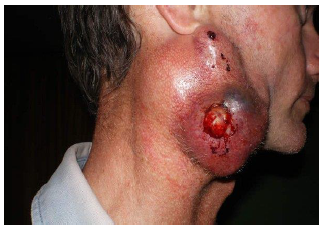
Figure 1: Neck cancer.
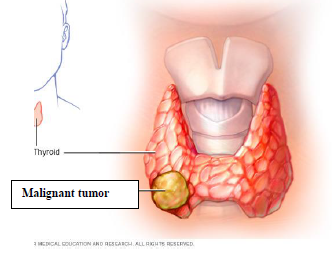
Figure 2: Thyroid cancer.
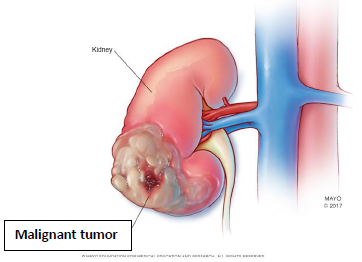
Figure 3: Kidney cancer.
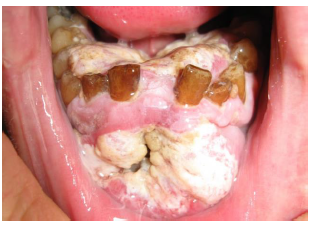
Figure 4a: Mouth cancer.
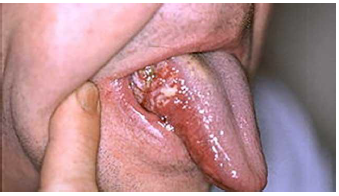
Figure 4b: Mouth cancer.
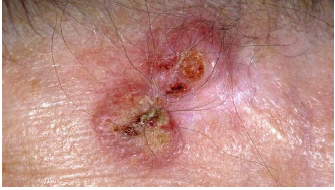
Figure 5a: Skin cancer.
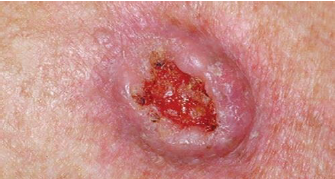
Figure 5b: Squamous cell carcinoma, a common skin cancer.
Abnormal or uncontrolled growth of cells. When it is said a cancer cell, the fact that the cell is a host whereas the cancerous genome inside it is an autointracellular pathogen is missed. In other words, the scientific truth of the disease called cancer is not compatible with the language it has to be imparted. The only cause that changes a normal cell into a cancered cell is the state of being changed or transformed of the genome by a multitude of mutations inside the normal cell. The multitude of mutations are reffered to as driving mutations for they are the driving force of metastatic growth of cancered cells.
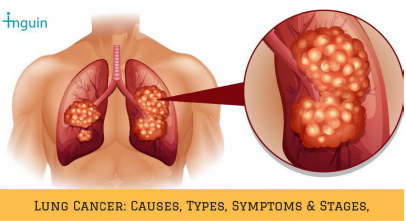
Figure 6: Lung cancer.
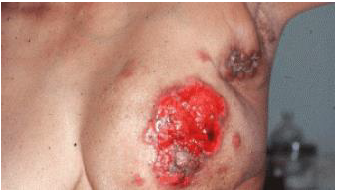
Figure 7a: Advanced breast cancer symptom.
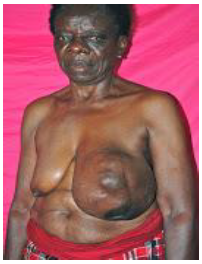
Figure 7b: Advanced breast cancer symptom.
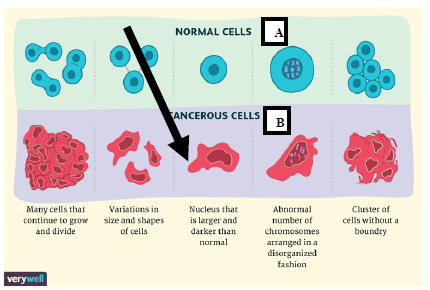
Figure 8: Morphology of normal cells and that of cancered cells (Eldridge L, Hughes G, 2017, 16).
In Fig. 8, B, the term “cancerous cells” means that cancerous cells (i.e., cancer cells) are the causative agents of the disease called cancer. It means that cancerous cells or cancer cells are pathogenic cells that cause cancer. This meaning & concept is completely wrong and ignorant of the role of genome in all living-things. In the events & context of cancer, cancerous cells or cancer cells are host cells or cancered cells and not pathogens that cause cancer. The actual pathogen in causing cancer is the autointracellular pathogenic genome or cancerous genome found inside the cancered cell (host cell). The term cancered cell means the infected host cell with the autointracellular pathogenic genome. The genome transformed by a multitude of driver mutations is said pathogenic, because it causes the horrible disease called cancer. A cancerous cell or a cancer cell is erroneous, unpulverized, and a turbid term with incompatibility that has been misleading students & confusing scientists of biological sciences of the world for centuries until the emergence of of this paper. As internal components of cancer, the host cell & pathogen are undistinguished; because of this, the consciousness of man about cancer is beating around the bush and the target point has not been realized in order to devise effective scientific treatment.
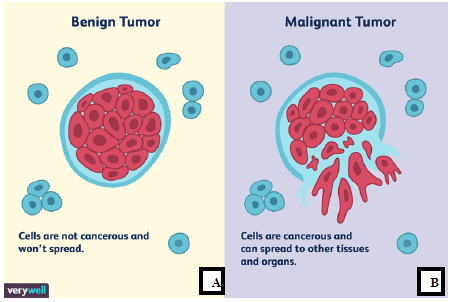
Figure 8: Comparison between benign tumor and malignant tumor (Eldridge L, Hughes G, 2017, 21).
3. Conclusion
Cancerous genomes are autointracellular pathogens inside the cancered cells. The biomass of normal cells is produced by the coded information of their normal genomes whereas the biomass of cancered cells is built or produced by the coded directives or information of their cancerous genomes. The role of uncontrolled rapid division & the subsequent metastatic growth by spreading to different regions of the patient’s body and settling there as new malignant tumors is played by the pathogenic genome of the cancered cell, forming blood vessels by way of angiogenesis for nutrient supply. Therefore, the most appropriate or addressive & self explanatory term for cancer is “cancerous genome” and not “cancer cell”. The only structure that builds a cell or a virus of any species of all living-things is the genome found inside that cell or virus. It is only the cancerous genome that is responsible for
making a cell a cancered one. A normal genome builds or generates normal cells whereas cancerous genome builds or generates cancered cells, using its nutritive substances as raw materials [1]. In other words, a cancered cell means a cell that is infected with an autointracellular pathogenic genome or cancerous genome. When a host cell is infected with an intracellular pathogenic virus, it is termed as an infected cell, then the most appropriate and equivalent term for the infected state of a cell with an autointracellular pathogenic genome (autointracellular cancerous genome) is a cancered cell. This is why that the terms infected cell and cancered cell were recognized similarly by immunologically competent cells such as NK cells and cytotoxic Tc cells and both the virus-infected cells and the cancered cells are killed/lysed by similar mechanism of attack from NK cells and cytotoxic Tc cells. This is so because the scientific truth must be logically compatible with the language it has to be imparted through. In this pathological context, the term cancered means “infected with autointracellular pathogenic genome” that results in cancer.
The scientific truth & the terrifying danger we suffer from cancer and imparted by the term cancerous cell or cancer cell is erroneous, unpulverized, unfit or turbid, being targetless so that it cannot be used in academic lessons for learners/readers and as the result of this incompatibility it has been misleading students & confusing scientists of biological sciences of the world for centuries until the emergence of this paper. Therefore, using cancerous cell or cancer cell as a term in modern textbooks, articles of journals and in any scientific work must be banned completely. The outcome of this study is strongly believed to empower researchers of cancer & health professionals to devise effective and optional methods of choice or strategies in fighting against cancer because their consciousness about cancer will be free from beating around the bush as the host & its autointracellular pathogen that are essential for the occurrence of cancer are spectacularly distinguished to get the target accurately.
Ethics
No ethical error is seen or committed in the execution of this study.
Competing Interests
I declare that I do not have any competing interests with anybody.
Acknowledgements
I am deeply grateful to the scientists acknowledged in the text and list of references of this paper for their providing me with confidential data (that can be counterchecked for their correctness with the observable facts in the natural environment) as well as from modern textbooks, reputable journals, and internet. I am sincerely thankful to all scientists of the world engaged in the fields of both pure and applied biological sciences because it could be impossible for me, to come up with this paper of concepts and principles, without their collective contributions of accurate scientific investigations that empowered me by serving as concrete evidences for the valid emergence of this paper. This is so because science cannot develop without science.
References
- Bagnall JS, Byun S, Begum S, et al. Defrmability of tumor cells versus blood cells. Scientific Reports 5 (2015): 1-19.
- Ertel A, Verghese A, ByersSW, et al. Pathway-specific differences between tumor lines and normal and tumor tissue cells. Mol Cancer 5 (2006): 55.
- Doonan JH, Sablowski R. Walls around tumors-why plants do not develop cancer. Nat Rev Cancer 10 (2010): 794-802.
- Smith EF. Studies on the crown gall of plants: Its relation to human cancer. Cancer Res 1 (1916): 231-309.
- Eldridge L, Hughes G. Cancer cells vs normal cells: how are they different? (2018): 16-21.
- Adam JK, Odhav B, Bhoola KD. Immune responses in cancer. Pharmacol Ther 99 (2003): 113-132.
- Houghton AN. Cancer Antigens: Immune recognition of self and altered self. J Exp Med 180 (1994): 1-4.
- Blair GE, Cook GP. Cancer and the immune system: an overview. Oncgene 27 (2008): 5868.
- Janssen LME, Ramsay EE, Logsdon CD, et al. The immune system in cancer metastasis: friend or foe? Journal for ImmunoTherapy of Cancer 5 (2017): 79.
- Adam JK, Odhav B, Bhoola KD. Immune responses in cancer. Pharmacology & Therapeutics 99 (2003): 113-132.
- Cancer Treatment Centers of America. How does the immune system work? When it comes to cancer it’s complicated (2017).
- Finn OJ. Immuno-oncology: understanding the function and dysfunction of the immune system in cancer.Annals of Oncology 23 (2012): viii6-viii9.
- Pandya PH, Murray ME, Pollok KE, et al. The immune system in cancer pathogenesis: potential therapeutic approaches. J Immunol Res (2016): 4273943.
- Saini DK, Saini D. Basic concepts of immunology. New Dehi: Peepee Publishers and Distributors Ltd, (2004): 84-85.
- Male D, Brastoff J, Roth DB, et al. Immunology. (Edn 7) UK: MOSBY Elsevier (2006): 91-528.
- Barrett. Microbiology and Immunology Concepts. USA: Lippincott-Raven Publishers (1998): 113.
- Feleke E. Genome model of living-things, definition of a living-thing, and the position of biological viruses among living-things. International Journal of Current Research 9 (2017): 53764-53778.
